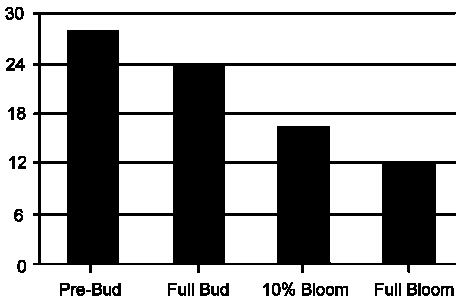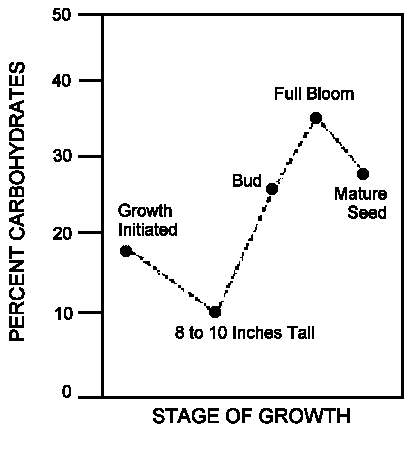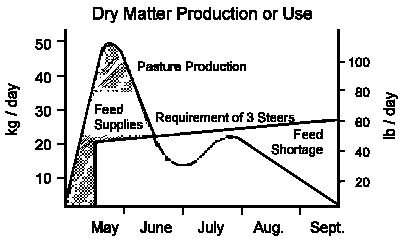Grazing Alfalfa with Horses
- Why Alfalfa?
- Three Categories of Alfalfa
- Carbohydrate - Root Reserves
- Grass Growth Pattern
- Rotational Grazing
Why Alfalfa?
There are a number of reasons to consider grazing horses on predominantly alfalfa pastures.
- widely adapted to various soil types
- more uniform seasonal production than grass
- total volume of forage is greater than with grasses
- quality of forage remains good throughout growing season
- horses don't bloat on alfalfa
- surplus production in a good year can be harvested for hay
- fertility requirements for maintenance are less than for grasses - as a legume alfalfa fixes nitrogen from the air
- establishment is easier than grasses
Alfalfa will grow on sandy, loam and clay soils. Poorly drained soils where water ponds for 7 to 10 days in the spring can cause loss of plants and eventually stand loss.
Alfalfa's potential for regrowth after it is grazed is one of the reasons it produces more pounds of quality forage than any of the grasses. This is particularly true on light sandy soils. Protein and T.D.N. (total digestible nutrients) values of alfalfa provide adequate nutrition even when close to being fully mature.

The type of alfalfa selected for grazing purposes is important if you want a stand to survive grazing pressure. The tap-rooted varieties fall into the Early and Medium maturing categories. They are used primarily for hay production. Creeping rooted varieties are the hardiest and will withstand grazing pressure and adverse conditions better than the other two categories.
Three Categories of Alfalfa
Alfalfa varieties are grouped into three categories because of different characteristics.
Category |
Primary Use |
Pros |
Cons |
| Early Maturing | Hay |
|
|
| Medium Maturing | Hay |
|
|
| Creeping Rooted | Pasture and Hay |
|
|
Carbohydrate - Root Reserves
Understanding the relationship between root reserves and how the plant grows is important if the stand is to survive for any length of time under a grazing situation. With the initiation of growth in the spring or following removal of the top growth by cutting or grazing, carbohydrate reserves are utilized to produce new top growth.
Reserves are lowest during the early vegetative period and highest at full maturity. Usually root reserves decrease between full bloom, and the mature seed state as tiller formation or new vegetative growth occurs.
Once alfalfa reaches 8 to 10 inches (20 to 25 cm), food reserves begin to replenish as the plant produces more food than it needs for maintenance and growth. Replenishment is complete by the full bloom stage.

For alfalfa to persist the root reserves should be as close to maximum as possible when the plants are going into the winter.
Reserves are used to develop heat and cold tolerance to maintain life during dormancy and to get the plants started next spring. After the first killing frost (-6º C to -8º C for alfalfa) little depletion or replenishment occurs in the root system.
Grass Growth Pattern
Most grasses produce the majority of their growth in the early summer. Once grazed off, little regrowth occurs, especially in late July and August.
In July and August horses consistently need good quality forage - the colt is getting bigger and the mare should be putting on conditioning in readiness for the collection period. Alfalfa can provide the nutrition required during this period. Grasses have lower protein and T.D.N. values when they mature than alfalfa.
Meadow Brome is the newest pasture grass species available. It will regrow in July and August if moisture is available. It grows different than smooth bromes and is less aggressive in a mix with alfalfa. A seeding rate of 7 lbs (3.2 kg)of alfalfa with 3 lbs (1.4 kg) of Meadow Brome/acre would be a good mix for pasturing in most areas.

Rotational Grazing
Grazing on a rotational basis with at least 3 and preferably 4 paddocks allows the alfalfa to maintain adequate root reserves. Begin grazing of alfalfa when plants are 6 to 8 inches high in the first paddock. This will occur mid-May, depending on location and soil type.
Moving through the first 3 paddocks quickly at the beginning of the season is advisable. The more leaf and plant material that is left in these early states of growth, the faster the plants will recover. By the first week in June, paddock 4 should be close to the early bud stage and root reserves would be about 75 per cent replenished which is acceptable. Start lengthening out the grazing period as the alfalfa gets more mature.
Paddock 1 |
Paddock 2 |
Paddock 3 |
Paddock 4 |
May 15-19 (5 days) |
May 20-24 (5 days) |
May 25-31 (7 days) |
June 1-20 (20 days) |
June 21-July 10 (20 days) |
July 11-31 (20 days) |
Cut End of June |
Aug 1-15 (15 days) |
Aug 16-20 (5 days) |
_ |
Aug 21-31 (11 days) |
_ |
| Total - 108 days | |||
Next year's grazing would start in the spring on Paddock 2. If conditions were good it would be possible to take a cut of hay after mid-September on Paddock 2. Grazing would then start on Paddock 4 the following year. Whichever paddock has the most rest in the fall should be grazed first, the following spring.
Example: 60 Acre Field - Four Paddock Design
This example is based on a 60 acre field divided into four paddocks. One band of horses is being grazed in this field.
Assumptions
1 band of horses consists of :
- 17 mares and foals
- 1 stud
- 1700 lbs average weight
Consumption - 60 lbs dry matter/day/unit
Grazing Season - 108 days
Total Seasonal Requirements for Grazing Unit
18 x 60 x 108 days = 116,640 lbs
Production at 2,000 lbs/acre
2,000 x 60 acres = 120,000 lbs
Production at 3,000 lbs/acre
3,000 x 60 acres = 180,000 lbs
At 2,000 lbs production/acre the entire 60 acres would be required for grazing. 3,000 lbs of dry matter production would result in 30 tons of surplus hay.

